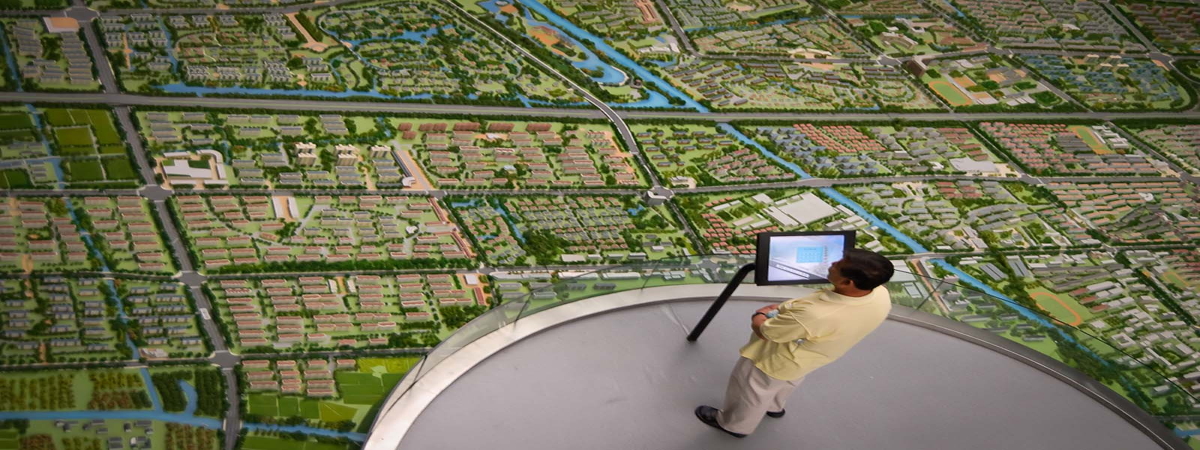
Regardless of the fact that there is a technological factor that advances unstoppably impacting all areas of our lives, and that inevitably affects the development of our cities, in the same way that it affects the development of business worldwide, the way we organize ourselves, the lifestyle we lead or the geopolitical structure that society takes, the proposals for converting a city into its “Smart City” counterpart go beyond simply being carried away by this wave of progress that moves humanity towards levels and levels of development not known until now.
With more than 50% of the world’s population now urbanized, and with population growth forecasts for the coming decades, the transformation of cities, towns and cities in their counterparts “Smart”, or intelligent, is not simply to be dragged along by technological innovations and to implement everything that is being developed by the scientific and technical community, but a need to prevent and foresee, over the coming decades, a collapse in the way of life of all of us, because we cannot offer quality services and infrastructures to a greater number of people who come to make cities their home.
The rate of growth is particularly rapid in many of the so-called megacities, cities with populations of more than 10 million inhabitants that are increasingly the engines of growth of their respective national economies, so that as urban economies grow, so do their challenges.
The paradigm of economic and social wellbeing derived from life in cities is becoming a myth in the face of the growing demographic explosion, which has led to the collapse, in several cases, of the standard of living and quality of life of their inhabitants, thus breaking with its fundamental premise, since the viability of a city is based on the efficient functioning of its infrastructure, which translates into sufficient energy, transportation, security and mobility services; In other words, to achieve quality of life, the city must be able to offer the best quality of life possible, and the city must be able to offer the best quality of life for its inhabitants, and the city must be able to offer the best quality of life possible.
In other words, achieving quality of life in a city fundamentally requires changes in its infrastructure, since an efficient infrastructure contributes to economic prosperity and to improving the lives of its inhabitants. Therefore, to transform the city we transform its services and structures, and, for this reason, all the technologies that are now at the base of the transformation of a city into a Smart City are focused on these areas in a priority and concrete way.
The ecosystem of a city is complex and the process is a long one
The complexity of the social ecosystem in cities and urban areas has increased, making their sustainability an important factor. This ecosystem as a whole is experiencing in this second decade of the 21st century great economic upheaval, a high rate of urbanization, climatic variations and high population growth. These factors can hinder growth when there is no control over them, causing our cities to become disorderly and disorganized, for, the greater the number of residents, problems related to health, traffic, pollution, resource scarcity, waste and infrastructure management tend to increase and, therefore, the development of the city crumbles if automated management measures and control of all areas critical to its proper functioning are not implemented.
Since the emergence of problems related to the overpopulation of cities hinders growth and decreases the standard of living and quality of life of its inhabitants, the non-transformation of a city into a Smart City can completely dismantle all the development achieved in recent decades. This perspective is, partially, what has triggered the use of technology as a solution to all these problems and what has been at the basis of the Smart City concept since its inception, since, smart cities, guarantee a sustainable environment with the help of huge amounts of data taken from all city services, using technologies such as the Internet of Things (IoT), the new generation 5G telephone networks, improvements in the home automation of our homes or with the introduction of automatic driving of vehicles through our streets. Thus, by “smart”, it is understood that the city is more sustainable, livable and efficient in all the services it offers to its inhabitants.
Understanding the Smart City
Although the concept of Smart City is still confusing in the minds of many people, it is a “word” and an idea that, little by little, is reaching the mass of society, going from being a topic of conversation almost exclusively among groups of innovators who live by and for technological development, to reach the so-called early-adopters, people who begin to use these concepts before they become a topic of common and daily use for the majority, and where we all understand what it means that our city wants to transform, or is transforming, into a Smart City.
In any case, for a city (its governors and management team, it is understood) to initiate a process to even consider what possibilities exist to transform it into a Smart City, there are several macro areas that must be taken into account to decide, within the wide range of possible actions on the city, which are more priority, necessary or economically viable. Thus, we should take into account, for example:
- The relief and natural conditions of the city: observe where the city is physically developed, i.e., possible hazards such as avalanches, earthquakes, floods, pollution, etc., which define the implementation of technologies that help prevent disasters and natural catastrophes as a first priority.
- The development structure of the city, i.e., how the city has developed spatially under the influence of political, economic and social forces and how “willing” the citizens are to undertake the works and structural changes required by the technological transformation implied by a Smart City
- The demographic structure; concerning the population and migratory index of the city, where we must have well studied the scope of services, their capacity, their response and sizing in the face of a sustained and prolonged growth of the number of inhabitants that will arrive in the coming years, and what kind of technologies will allow us to accompany this growth, being very important that they are scalable models at a technical level for this.
- The city’s transport structure, which is usually one of the first elements that we try to make “intelligent” by automating and improving all its management systems, including the impact of its emissions into the atmosphere, the growing need for space for its expansion, the congestion that this generates, the areas of the city currently without transport services or with precarious services, etc.
- The structure of the city’s facilities, including health, education, justice, commerce, security, communications, etc., which must be transformed into their “smart” counterparts.
- The structure of green areas, parks and gardens, which indicates the disposition and availability of green areas per inhabitant and which, undoubtedly, are part of the urban ecosystem to increase the quality of life of residents.
An analysis of the above points, and others that may be added according to the singularities that each city has, makes it possible to guarantee sustainable development and quality of life in the complex social ecosystems of cities and urban areas.
The foundations of the Smart City
“Smart Cities” have not been born “out of nothing”, everything, as in any area of human evolution, goes in phases and has a precedent on which the processes of change are supported. A precursor to the smart city has been the concept of the digital city, a technologically advanced city that uses the broadband communications infrastructure already widespread across the planet to support e-governance and an online environment for public transactions and management.
From this idea, which has been decades in development in many cities around the world, the notion of the smart city has been established from the combination of the knowledge society and improvements in the “digital” city. Combining both functions as precursors of the Smart City concept, we can understand the dynamics of transformation of a city into a Smart City as the transition to a multi-layered territorial system of innovation, composed of digital networks, individual intellectual capital and the social capital of the city, which together constitute the collective intelligence that ends up manifesting an urban ecosystem governed by technologies that serve the population to sustain a high level of livability and a constant quality of services.
Pillars that support the need to turn our cities into smart cities
Every element and component of the city is important. None of them can function in isolation from the rest of the services present in the city and all of them must be taken into account to be able to “justify”, if necessary, why we need to initiate technological transformation processes to turn a city into a smart city. However, we can say that there are several areas that are the ones that mark, in some way, the reasons and needs that give rise to these transformation projects.
The pillars or factors, at least for most cities on the planet, that justify the time, energy and investment in the conversion to a Smart City are the social environment, the search for better management and governance, the local development of the economy, the use of new technologies and the search for a model of sustainability. Let’s look at them in more detail.
Social environment
The possibility for all citizens to communicate with each other, and with the agencies and groups that represent them, underpins the idea that smart cities must be supported by communities whose citizens can actively participate in their design. There are currently many initiatives in which residents can access information about what is happening in their neighborhoods and cities, but ways to increase participation in the city design and planning process can also be explored. Mechanisms for this, data, scenarios and models are readily available to the population, thanks to contemporary ICTs. Current forms of participation respond to new technologies, since everyone has a cell phone on which they can download an app where they can interact with their city council, and the media and improvements in the websites of these and other management bodies are increasing this type of interaction, since both data and information and future plans are shared, and citizens can vote, give their opinion or decide to a greater or lesser extent on them.
Therefore, cities that are “smart” only with respect to their economy or technological systems implemented in some services are not smart at all if they do not take into account the opinions of their citizens and their participation. In addition, smart city transformation initiatives must be sensitive to balancing the needs of the different communities that make up the city, because any project we implement to transform a system or service into its “Smart” counterpart has an impact on the quality of life of citizens, and they must be part of it.
City management
Governance is a major implementation challenge for smart cities. Limited transparency, fragmented accountability of departments and management bodies, uneven divisions of the city, and resource leakage are some of the integral characteristics of municipal management that we find in every city on the planet.
Moving from this type of city governance to a digital model is essential for an effective and efficient administration, seeking to include political and active participation in citizen services and to promote the use of “e” administration through ICTs. At the end of the day, it is about implementing “smart” initiatives to improve the decision-making process, the elaboration of public policies, the maintenance plans of the city, the changes it needs, the reforms that must be made to make it sustainable for the next generations, etc. Communication applications through our cell phones and websites of city councils and municipal bodies are the channel most used by many cities for this purpose and, therefore, the management teams of cities in the process of becoming Smart Cities must enhance it to identify the needs and desires of the different target groups and address them in the most effective and convenient way.
Fortunately, digital governance is already part of many smart city initiatives to enable citizens to participate in the governance and management of it and become active users in it. If all of us who live in a city are key players in its changes, we can have the opportunity to engage with the transformation process to the extent that we can influence whether the change is a success or a failure.
Economy
The economy, and how good or bad it is, is one of the main drivers for the implementation of city transformation initiatives. A key indicator to measure its growth is the city’s capacity as an economic engine, and whether the technological improvements implemented in it increase, and are reflected in an improvement of the economy under the “Smart City” model.
Since the purpose of any technological transformation project is to make a city offer better economic opportunities, to make it more efficient in the use of its resources and to minimize the cost of its management and maintenance, inevitably thinking about the transformation towards a “Smart” model means analyzing all the costs and benefits in financial terms, since a Smart City, as one would expect, supports the maximization of efficiency in the use of the city’s resources. Economic growth in Smart Cities must be constant due to the short life cycle of ICTs and the speed with which they evolve. Moreover, as a platform for economic and business development, the smart city facilitates the flow of capital, which comes from the hand of local, national or foreign investments, looking for opportunities to maximize investment in new projects and new technologies.
For this reason, business involvement and activity in any urban project is one of the central axes of smart cities, and the creation of an environment for industrial development is fundamental to their success. The economic outcomes of smart city initiatives are business creation, job creation, workforce development and productivity improvement.
Technology
For an “ordinary” city to transform into a “smart” city, technology plays a key role. Modern cities are becoming increasingly smart thanks to the rapid evolution of advances in areas of knowledge that, in just a few years, have become disruptive resources, encompassed within a macro paradigm called Industry 4.0.
Thanks to a whole set of technologies, problems arising from the management and maintenance of a city can be avoided in many cases, or anticipated and mitigated by analyzing the enormous data available from networks of sensors and devices that allow us to monitor the functioning of our city. This is where big data, artificial intelligence, 5G and soon 6G communications, decentralized blockchain storage technology, the Internet of Things (IoT), the development of digital twins of the city, etc. come into play. Smart Cities must exploit these technologies to increase sustainability and improve the quality of life of citizens.
Thus, the use of the aforementioned technologies can certainly raise the standard of living of the inhabitants by being able to offer them better and more efficient services at lower cost, but it also faces strong challenges. Technologically sound human resources with practical skills in these new areas are currently limited, so educating and training people in such new and disruptive IT skills can be a great challenge, but there is no other way, as a Smart City relies on all of the above in order to successfully conclude its transformation.
Sustainability
Sustainability could be defined as the way to achieve economic and social development without altering the environment. In a city this definition would encompass the main operating mechanisms of urban environments, including water, energy and food supply, transportation and greenhouse gas emissions. The desire to live in a sustainable city that respects the natural ecosystem is another driving force behind Smart Cities projects.
Since cities consume 75% of our energy resources and emit 80% of the carbon that damages our environment, reducing the impact of cities on the planet is a huge motivation to encourage the deployment of the technologies mentioned above, and to integrate them into existing city infrastructures. At the same time, it is also imperative to increase the resilience of cities to environmental shocks and changes. A smart city leads to decreasing the environmental consequences of urban life by reducing its carbon footprint, improving waste generation and recycling, making better use of water and energy resources, and so on.
In short
With the steady increase in population levels and the sudden population explosion in cities, the urban challenges faced by cities across the globe have increased to an unprecedented level. This is expected to continue with further increases in pollution levels, resource scarcity, traffic and much more. Cities today face new economic, political and technological responsibilities that must be met to deliver sustainable prosperity to their citizens. It is time to harness technology and establish smarter systems that can optimize the use of their limited resources.
Many cities have already begun to implement these changes, but it is essential to act quickly, as the need to provide sustainable development and meet the needs of the growing population without disturbing the environment will be critical within a few decades. Let us make our current cities the engines of change for societal transformation, becoming allies of the environment and natural ecosystems to harness their resources responsibly, putting in place technological solutions that provide effective management systems, and let us seek ways to have a population involved in the governance of their city, for, after all, it is our home, and the place we must care for and improve for ourselves now and for those who will come to occupy it in the future.



